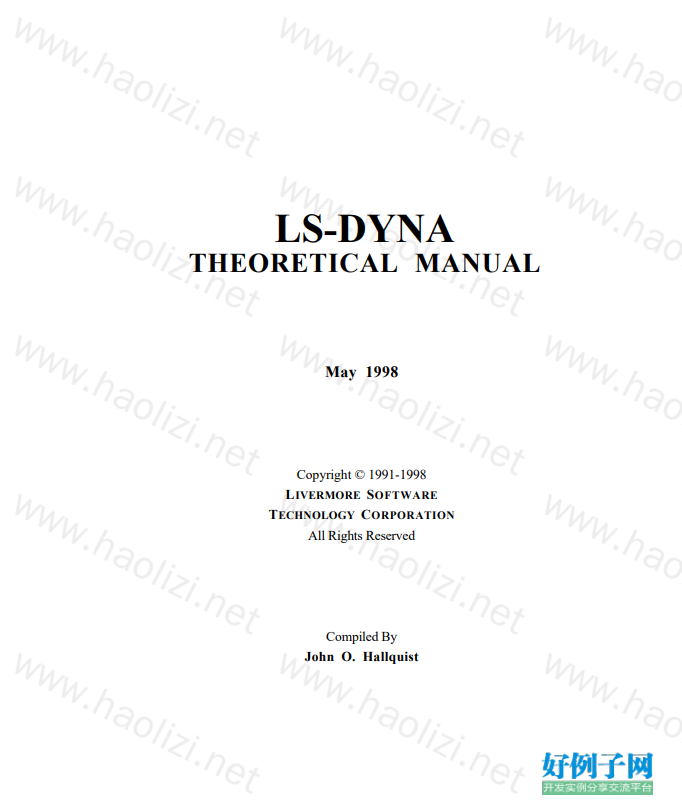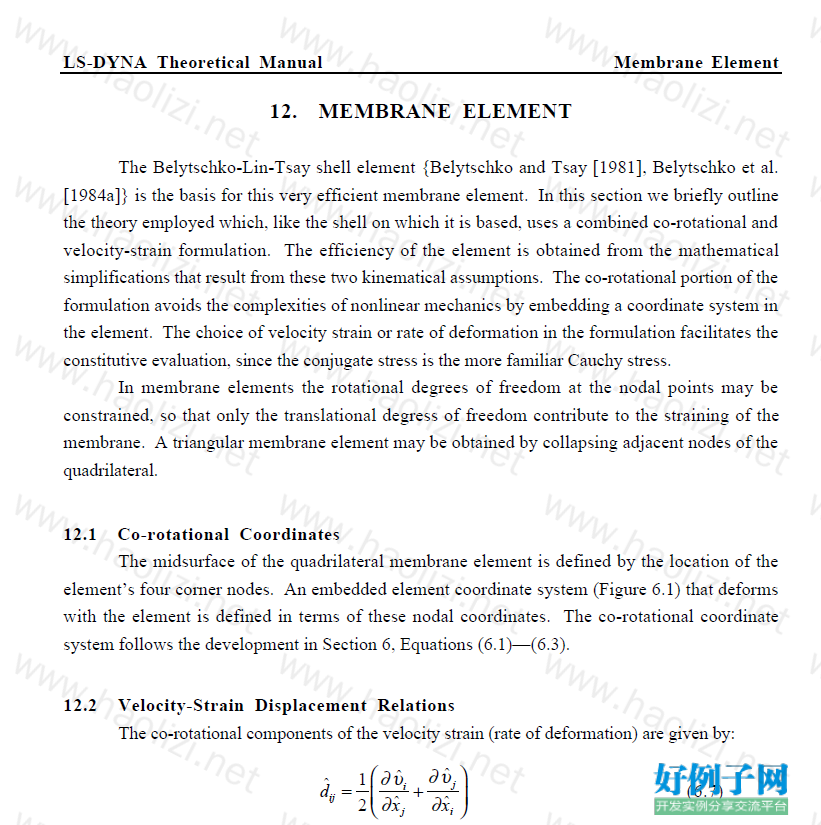实例介绍
【实例截图】


【核心代码】
TABLE OF CONTENTS ABSTRACT ......................................................................................................................... 1.1 1. INTRODUCTION.............................................................................................................. 1.1 1.1 History of LS-DYNA ..... 1.1 .............................................................................................. 1.2 Acknowledgments........ 1.10 ............................................................................................... 2. PRELIMINARIES............................................................................................................. 2.1 2.1 Governing Equations .... 2.1 ................................................................................................ 3. SOLID ELEMENTS 3.1 .......................................................................................................... 3.1 Volume Integration ..... 3.3 ................................................................................................. 3.2 Hourglass Control........................................................................................................ 3.4 3.3 Fully Integrated Brick Elements 3.9 ...................................................................................... 3.4 Fully Integrated Brick Element With 48 Degrees-of-Freedom 3.10 ............................................... 3.5 Tetrahedron Element With 12 Degrees-of-Freedom............................................................. 3.13 3.6 Fully Integrated Tetrahedron Element With 24 Degrees-of-Freedom....................................... 3.14 3.7 Integral Difference Scheme as Basis For 2D Solids 3.17 ............................................................ 3.8 Rezoning With 2D Solid Elements................................................................................. 3.23 4. BELYTSCHKO BEAM ..... 4.1 ................................................................................................. 4.1 Co-Rotational Technique 4.1 ............................................................................................. 4.2 Belytschko Beam Element Formulation 4.5 .......................................................................... 4.2.1 Calculation of Deformations................................................................................ 4.6 4.2.2 Calculation of Internal Forces 4.7 .............................................................................. 4.2.3 Updating the Body Coordinate Unit Vectors............................................................ 4.9 5. HUGHES-LIU BEAM ........ 5.1 ................................................................................................ 5.1 Geometry.................................................................................................................. 5.1 5.2 Fiber Coordinate System 5.6 ............................................................................................. 5.2.1 Local Coordinate System 5.7 .................................................................................... 5.3 Strains and Stress Update 5.8 ............................................................................................. 5.3.1 Incremental Strain and Spin Tensors 5.8 ..................................................................... 5.3.2 Stress Update.................................................................................................... 5.8 5.3.3 Incremental Strain-Displacement Relations............................................................. 5.9 5.3.4 Spatial Integration 5.10 ............................................................................................ 6. BELYTSCHKO-LIN-TSAY SHELL 6.1 ..................................................................................... 6.1 Co-Rotational Coordinates............................................................................................. 6.1 6.2 Velocity-Strain Displacement Relations 6.3 ........................................................................... 6.3 Stress Resultants and Nodal Forces.................................................................................. 6.5 6.4 Hourglass Control (Belytschko-Lin-Tsay) 6.6 ......................................................................... Table of Contents LS-DYNA Theoretical Manual iv 6.5 Hourglass Control (Englemann and Whirley)..................................................................... 6.8 6.6 Belytschko-Wong-Chiang Improvement 6.10 .................................. LS-DYNA Theoretical Manual Table of Contents v 13.7 General Nonlinear . 13.7 ................................................................................................ 13.8 Linear Visco-Elastic . 13.8 ............................................................................................. 13.9 Seat Belt Material . 13.9 ................................................................................................ 13.10 Seat Belt Elements.... 13.10 .......................................................................................... 13.11 Sliprings........................................................................................................... 13.11 13.12 Retractors........ 13.11 .................................................................................................. 13.13 Sensors............................................................................................................. 13.15 13.14 Pretensioners...................................................................................................... 13.16 13.15 Accelerometers ..... 13.16 .............................................................................................. 14. SIMPLIFIED ARBITRARY LAGRANGIAN-EULERIAN 14.1 ..................................................... 14.1 Mesh Smoothing Algorithms 14.3 ................................................................................... 14.1.1 Equipotential Smoothing of Interior Nodes...................................................... 14.3 14.1.2 Simple Averaging 14.11 .................................................................................... 14.1.3 Kikuchi’s Algorithm................................................................................. 14.11 14.1.4 Surface Smoothing 14.12 ................................................................................... 14.1.5 Combining Smoothing Algorithms 14.12 ............................................................. 14.2 Advection Algorithms 14.12 ........................................................................................... 14.2.1 Advection Methods in One Dimension 14.13 ......................................................... 14.2.2 Advection Methods in Three Dimensions 14.16 ...................................................... 14.3 The Manual Rezone.... 14.24 .......................................................................................... 15. STRESS UPDATE OVERVIEW 15.1 ....................................................................................... 15.1 Jaumann Stress Rate.............................................................................................. 15.1 15.2 Jaumann Stress Rate Used With Equations of State 15.2 ..................................................... 15.3 Green-Naghdi Stress Rate 15.3 ....................................................................................... 15.4 Elastoplastic Materials 15.5 ........................................................................................... 15.5 Hyperelastic Materials............................................................................................ 15.9 15.6 Layered Composites . 15.11 ........................................................................................... 15.7 Constraints on Orthotropic Elastic Constants 15.14 ........................................................... 15.8 Local Material Coordinate Systems in Solid Elements 15.15 ............................................... 15.9 General Erosion Criteria For Solid Elements 15.16 ............................................................ 15.10 Strain Output to the LS-TAURUS Database 15.17 ............................................................ 16. MATERIAL MODELS 16.1 .................................................................................................... Model 1: Elastic............................................................................................................16.7 Model 2: Orthotropic Elastic 16.7 ........................................................................................... Model 3: Elastic Plastic With Kinematic Hardening 16.8 ............................................................. Plane Stress Plasticity..................................................................................... 16.12 Table of Contents LS-DYNA Theoretical Manual vi Model 4: Thermo-Elastic-Plastic 16.13 ................................................................................ Model 5: Soil and Crushable Foam 16.15 ............................................................................ Model 6: Viscoelastic ........ 16.17 ...................................................................................... Model 7: Continuum Rubber 16.17 .................................................................................... Model 8: Explosive Burn.................................................. LS-DYNA Theoretical Manual Table of Contents vii Model 42: Planar Anisotropic Plasticity Model............................................................. 16.67 Model 51: Temperature and Rate Dependent Plasticity.................................................... 16.68 Model 52: Sandia’s Damage Model............................................................................. 16.70 Model 53: Low Density Closed Cell Polyurethane Foam................................................ 16.71 Models 54 and 55: Enhanced Composite Damage Model 16.72 ................................................. Model 57: Low Density Urethane Foam 16.75 ...................................................................... Model 60: Elastic With Viscosity 16.77 .............................................................................. Model 61: Maxwell/Kelvin Viscoelastic With Maximum Strain 16.78 ...................................... Model 62: Viscous Foam 16.79 ......................................................................................... Model 63: Crushable Foam....................................................................................... 16.80 Model 64: Strain Rate Sensitive Power-Law Plasticity................................................... 16.81 Model 65: Modified Zerilli/Armstrong 16.82 ........................................................................ Model 66: Linear Stiffness/Linear Viscous 3D Discrete Beam.......................................... 16.82 Model 67: Nonlinear Stiffness/Viscous 3D Discrete Beam 16.83 .............................................. Model 68: Nonlinear Plastic/Linear Viscous 3D Discrete Beam........................................ 16.84 Model 69: Side Impact Dummy Damper (SID Damper) 16.85 .................................................. Model 70: Hydraulic/Gas Damper............................................................................... 16.87 Model 71: Cable 16.87 .................................................................................................. Model 73: Low Density Viscoelastic Foam.................................................................. 16.88 Model 75: Bilkhu/Dubois Foam Model 16.89 ....................................................................... Model 76: General Viscoelastic.................................................................................. 16.90 Model 77: Hyperviscoelastic Rubber........................................................................... 16.91 Model 78: Soil/Concrete 16.93 .......................................................................................... Model 79: Hysteretic Soil......................................................................................... 16.95 Model 80: Ramberg-Osgood Plasticity 16.96 ........................................................................ Model 81: Plastic With Damage 16.97 ................................................................................ Model 83: Fu-Chang’s Foam With Rate Effects............................................................ 16.97 Model 87: Cellular Rubber 16.100 ..................................................................................... Model 88: MTS Model 16.102 .......................................................................................... Model 90: Acoustic.... 16.103 ........................................................................................... Model 96: Brittle Damage Model 16.103 ............................................................................. Model 100: Spot Weld............................................................................................. 16.105 Model 103: Anisotropic Viscoplastic.......................................................................... 16.107 Model 126: Metallic Honeycomb............................................................................... 16.108 Model 127: Arruda-Boyce Hyperviscoelastic Rubber 16.110 ...................................................... Model 128: Heart Tissue 16.112 .......................................................................................... Model 129: Isotropic Lung Tissue 16.112 ............................................................................. Table of Contents LS-DYNA Theoretical Manual viii Model 134: Viscoelastic Fabric 16.113 ................................................................................. 17. EQUATION OF STATE MODELS.................................................................................... 17.1 17.1 Form 1: Linear Polynomial 17.2 .................................................................................... 17.2 Form 2: JWL High Explosive 17.2 ................................................................................. 17.3 Form 3: Sack “Tuesday” High Explosives 17.3 ................................................................. 17.4 Form 4: Gruneisen........ 17.3 ........................................................................................ 17.5 Form 5: Ratio of Polynomials 17.3 ................................................................................ 17.6 Form 6: Linear With Energy Deposition 17.4 ................................................................... 17.7 Form 7: Ignition and Growth Model 17.4 ......................................................................... 17.8 Form 8: Tabulated Compaction 17.5 ............................................................................... 17.9 Form 9: Tabulated................................................................................................. 17.5 17.9 Form 10: Propellant-Deflagration 17.6 .............................................................................. 18. ARTIFICIAL BULK VISCOSITY 18.1 ..................................................................................... 18.1 Shock Waves......................................................................................................... 18.1 18.2 Bulk Viscosity....................................................................................................... 18.4 19. TIME STEP CONTROL......... 19.1 ......................................................................................... 19.1 Time Step Calculations For Solid Elements 19.1 ................................................................ 19.2 Time Step Calculations For Beam and Truss Elements 19.2 .................................................. 19.3 Time Step Calculations For Shell Elements 19.3 ................................................................ 19.4 Time Step Calculations For Solid Shell Elements 19.4 ........................................................ 19.5 Time Step Calculations For Discrete Elements 19.4 ............................................................ 20. BOUNDARY AND LOADING CONDITIONS..................................................................... 20.1 20.1 Pressure Boundary Conditions........................................ LS-DYNA Theoretical Manual Table of Contents ix 23. CONTACT-IMPACT ALGORITHM.................................................................................. 23.1 23.1 Introduction........................................................................................................... 23.1 23.2 Kinematic Constraint Method 23.1 ................................................................................... 23.3 Penalty Method...................................................................................................... 23.2 23.4 Distributed Parameter Method 23.3 ................................................................................... 23.5 Preliminaries 23.4 ......................................................................................................... 23.6 Slave Search.......................................................................................................... 23.4 23.7 Sliding With Closure and Separation.......................................................................... 23.9 23.8 Recent Improvements in Surface-to-Surface Contact.................................................... 23.10 23.8.1 Improvements to the Contact Searching........................................................ 23.10 23.8.2 Accounting For the Shell Thickness 23.13 ............................................................ 23.8.3 Initial Contact Interpenetrations 23.14 .................................................................. 23.8.4 Contact Energy Calculation........................................................................ 23.16 23.8.5 Contact Damping 23.16 ..................................................................................... 23.8.6 Friction 23.19 .................................................................................................. 23.9 Tied Interfaces . 23.20 ................................................................................................... 23.10 Sliding-Only Interfaces......................................................................................... 23.23 23.11 Bucket Sorting ..... 23.24 .............................................................................................. 23.11.1 Bucket Sorting in TYPE 4 Single Surface Contact 23.26 ........................................ 23.11.2 Bucket Sorting in Surface to Surface and TYPE 13 Single Surface Contact 23.29 ........ 23.12 Single Surface Contact Algorithms in LS-DYNA.................................................... 23.29 23.13 Surface to Surface Constraint Algorithm................................................................ 23.33 23.14 Planar Rigid Boundaries...................................................................................... 23.36 23.15 Geometric Rigid Boundaries 23.38 ................................................................................ 23.16 VDA/IGES Contact 23.40 ........................................................................................... 23.17 Simulated Draw Beads 23.43 ........................................................................................ 23.18 Edge to Edge Contact 23.47 ......................................................................................... 23.19 Beam to Beam Contact 23.49 ....................................................................................... 24. GEOMETRIC CONTACT ENTITIES 24.1 ................................................................................ 25. NODAL CONSTRAINTS .... 25.1 ............................................................................................ 25.1 Nodal Constraint Sets .............. 25.1 ............................................................................... 25.2 Linear Constraint Equations 25.1 ..................................................................................... 26. VECTORIZATION AND PARALLELIZATION 26.1 .................................................................. 26.1 Vectorization 26.1 ......................................................................................................... 26.2 Parallelization........................................................................................................ 26.5 27. AIRBAGS .....................................................................................................................27.1 27.1 Control Volume Modeling 27.1 ....................................................................................... Table of Contents LS-DYNA Theoretical Manual x 27.2 Equation of State Model 27.3 .......................................................................................... 27.3 Airbag Inflation Model.... 27.5 ........................................................................................ 27.4 Wang's Hybrid Inflation Model 27.8 ................................................................................. 27.5 Constant Volume Tank Test................................................................................... 27.11 28. DYNAMIC RELAXATION AND SYSTEM DAMPING 28.1 ....................................................... 28.1 Dynamic Relaxation For Initialization........................................................................ 28.1 28.2 System Damping 28.4 ................................................................................................... 28.3 Dynamic Relaxation—How Fast Does it Converge? 28.5 ..................................................... 29. HEAT CONDUCTION ........ 29.1 ............................................................................................ 29.1 Conduction of Heat in an Orthotropic Solid................................................................. 29.1 29.2 Thermal Boundary Condtions.................................................................................... 29.2 29.3 Thermal Energy Balances 29.4 ......................................................................................... 29.4 Heat Generation 29.4 ..................................................................................................... 29.5 Initial Conditions 29.4 ................................................................................................... 29.6 Material Properties .... 29.4 ............................................................................................. 29.6 Nonlinear Analysis.... 29.5 ............................................................................................. 29.7 Transient Analysis.................................................................................................. 29.5 30. ADAPTIVITY................................................................................................................30.1 31. IMPLICIT .....................................................................................................................31.1 32. BOUNDARY ELEMENT METHOD 32.1 .................................................................................. 32.1 Governing Equations............................................................................................... 32.1 32.2 Surface Representation .... 32.2 ........................................................................................ 32.3 The Neighbor Array........ 32.3 ........................................................................................ 32.4 Wakes..................................................................................................................32.5 32.5 Execution Time Control 32.6 .......................................................................................... 32.6 Free-Stream Flow................................................................................................... 32.6 REFERENCES .................................................................................................................REF.1
标签: 有限元教程DYNA
小贴士
感谢您为本站写下的评论,您的评论对其它用户来说具有重要的参考价值,所以请认真填写。
- 类似“顶”、“沙发”之类没有营养的文字,对勤劳贡献的楼主来说是令人沮丧的反馈信息。
- 相信您也不想看到一排文字/表情墙,所以请不要反馈意义不大的重复字符,也请尽量不要纯表情的回复。
- 提问之前请再仔细看一遍楼主的说明,或许是您遗漏了。
- 请勿到处挖坑绊人、招贴广告。既占空间让人厌烦,又没人会搭理,于人于己都无利。
关于好例子网
本站旨在为广大IT学习爱好者提供一个非营利性互相学习交流分享平台。本站所有资源都可以被免费获取学习研究。本站资源来自网友分享,对搜索内容的合法性不具有预见性、识别性、控制性,仅供学习研究,请务必在下载后24小时内给予删除,不得用于其他任何用途,否则后果自负。基于互联网的特殊性,平台无法对用户传输的作品、信息、内容的权属或合法性、安全性、合规性、真实性、科学性、完整权、有效性等进行实质审查;无论平台是否已进行审查,用户均应自行承担因其传输的作品、信息、内容而可能或已经产生的侵权或权属纠纷等法律责任。本站所有资源不代表本站的观点或立场,基于网友分享,根据中国法律《信息网络传播权保护条例》第二十二与二十三条之规定,若资源存在侵权或相关问题请联系本站客服人员,点此联系我们。关于更多版权及免责申明参见 版权及免责申明



网友评论
我要评论